Quartz Watches: Past, Present, But No Future? – Reprise
by Martin Green
Nothing can stir up the watch world these days quite as much the launch of a new Apple watch.
Responses vary between placing an immediate order for one because it’s the latest must-have gadget to shrugging it off indifferently, “because it is not a watch.”
The smartwatch onslaught is a moment in time when the horological industry has taken to making a lot of references to that other calamitous moment (for mechanical movements) in history when the quartz watch was introduced. Back then, quartz watches took the world by storm, nearly destroying Swiss watchmaking in the process.
The evolution of Swiss quartz watches
There is one, big difference between the haute horlogerie industry’s reactions to the two potentially fatal events: while most traditional Swiss brands today have largely ignored the smartwatch, few brands ignored quartz.
Creating increasingly precise watches had been the collective aim of watchmakers long before Abraham-Louis Breguet had even thought about the tourbillon. At quartz’s time of development more than 50 years ago, quartz-regulated watches were just seen as a way of achieving a higher degree of precision.
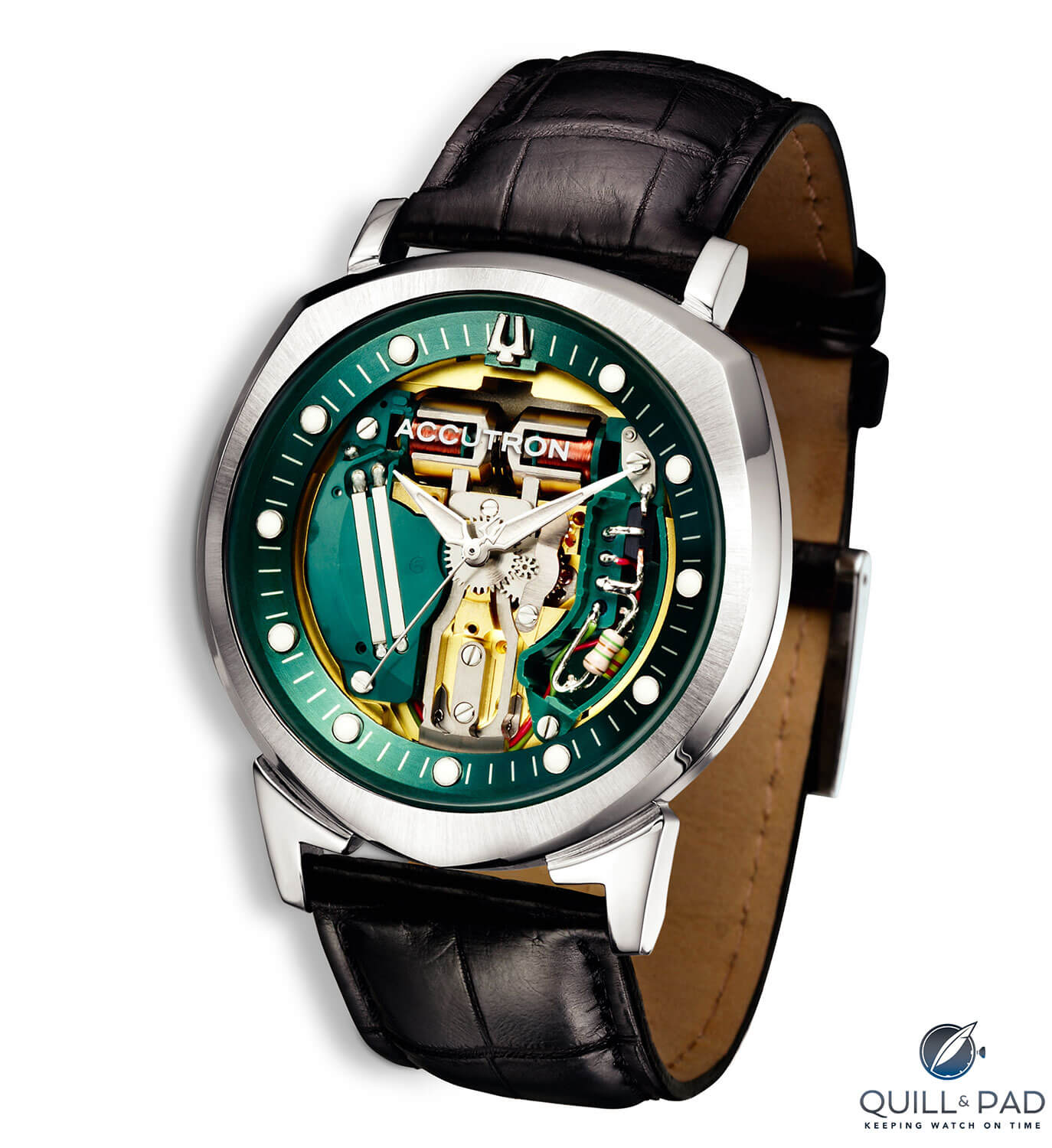
Bulova Accutron
Electric watches and the famous Accutron with its tuning fork movement had already shown that there was great potential in embracing this technology. That didn’t mean that it wasn’t outside of the comfort zone of many manufacturers, 16 of which decided to join forces with Ebauches SA (a movement maker) to form Centre Electronique Horloger laboratories (CEH) in 1962. Based in Neuchâtel, it formed one-third of the beginnings of today’s CSEM.
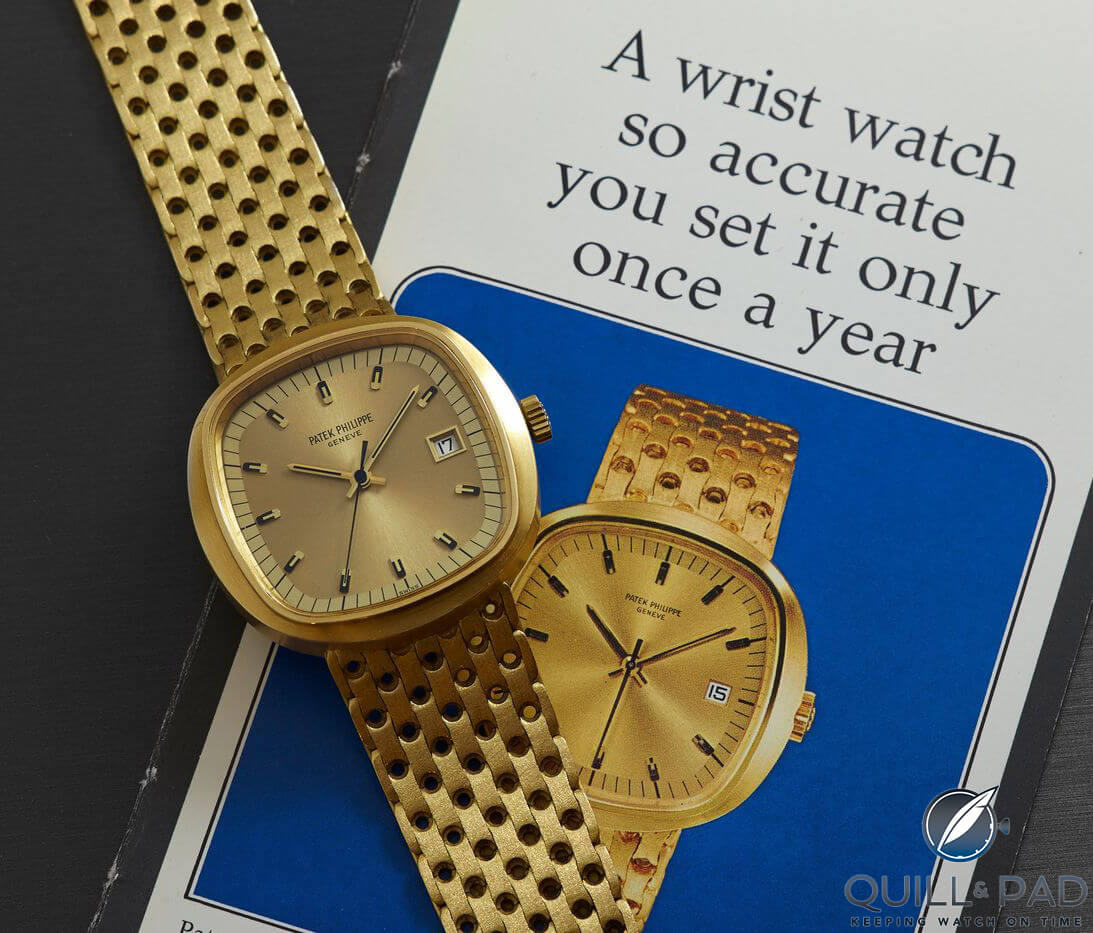
Patek Philippe Beta 21 and advertisment (photo courtesy Atom Moore and Christie’s)
CEH was an attempt to at least keep up with all the research and development into electronic regulators in both the U.S. (the United States still had a sizable watch industry in those days) and Japan.
The result of these Swiss collaborative efforts was the Beta 21, the first prototypes of which were first shown in 1967. It was commercially introduced in 1970, just after Seiko launched its first quartz watch, the Astron.
The quartz crisis that very nearly doomed the Swiss watch industry wasn’t because the Swiss watch brands were caught off guard but because brands misread the future of quartz.
High-end watch companies thought that high-precision quartz regulators would feature in exclusive, beautifully finished movements that they could sell at a premium over mechanical movements, while the Japanese worked rather quickly to set up efficient production of low-priced quartz movements, allowing them to undercut the expensive Swiss watches.
Beta 21 design issues
It also didn’t help that the Beta 21 drove the design departments of many esteemed Swiss manufactures mad!
In the late 1960s elegance still ruled (see 60 Years Of Piaget Altiplano: Sophisticated Style Versus Fugitive Fashion), supported by refined, small, and slim mechanical movements.
The Beta 21 was none of that.
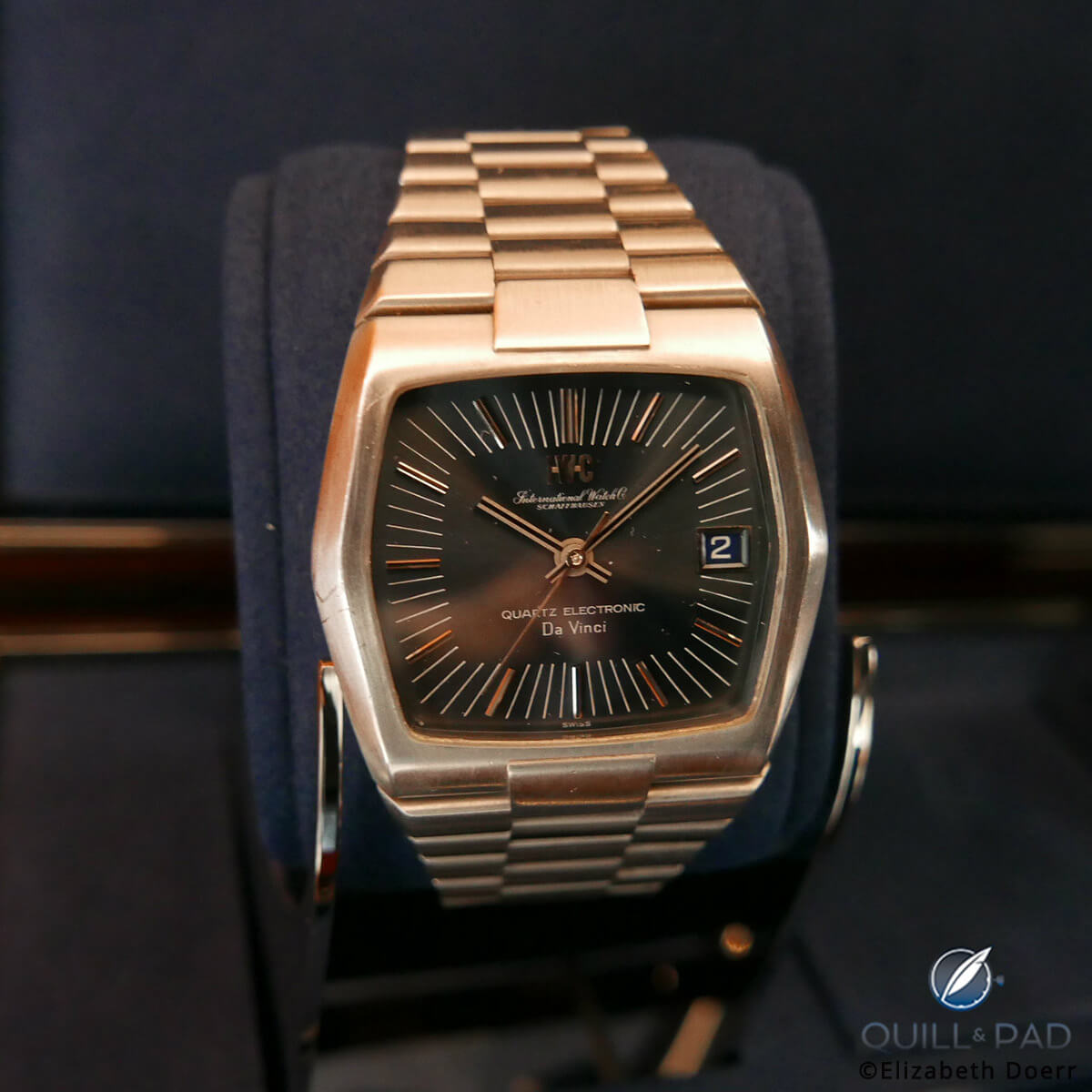
IWC Da Vinci Beta 21 from 1969
Rolex decided to forgo its signature Oyster case; Omega adopted a brick-like design for its watches housing the ungainly quartz movement; and Piaget made a stepped case with so many steps that it looked like it was attempting to reach heaven. Jaeger-LeCoultre never used the Beta 21 in a production watch, opting instead for the movement that Girard-Perregaux developed together with Motorola – not that this movement wasn’t any less chunky.
As quartz technology further developed, the Swiss were able to integrate it better and better into their collections.
After the Beta 21, Omega created an impressive range of quartz watches with interesting variations that even included the very first quartz watch to ever be awarded chronometer status (by Neuchâtel’s observatory, by the way); it is still considered one of the most accurate non thermo-compensated production watches ever made.
Girard-Perregaux developed some interesting complications for its quartz watches, and even Piaget became a full-blown manufacturer of quartz movements, making them smaller and thinner so they could be more easily integrated into the brand’s elegant watches.
Swiss quartz today
Today quartz watches are simply part of Swiss watchmaking.
Due to the renaissance of mechanical movements in the late 1980s and 1990s, quartz movements are now largely frowned upon by watch connoisseurs. Yet they have earned their place.
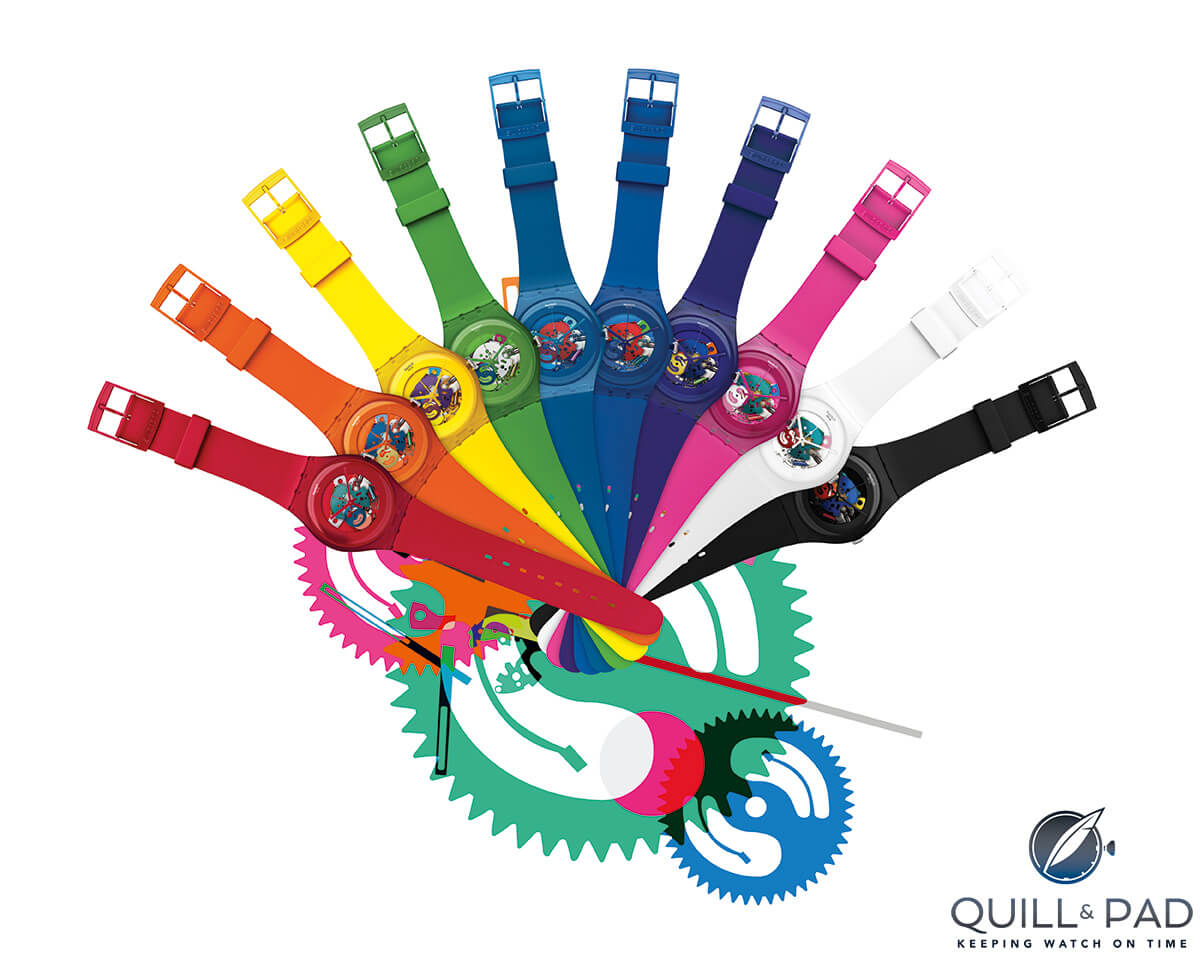
The Swatch watch arrived in 1983 and changed everything again
Swatch gets the credit for successfully reclaiming quartz for the Swiss by beating the Japanese at their own game: Swatch reduced the number of parts inside the quartz movement, thereby optimizing production, and put the movements in sharply designed, seasonal collections often sporting unique, if not outrageous, themes and selling the watches at very modest prices.
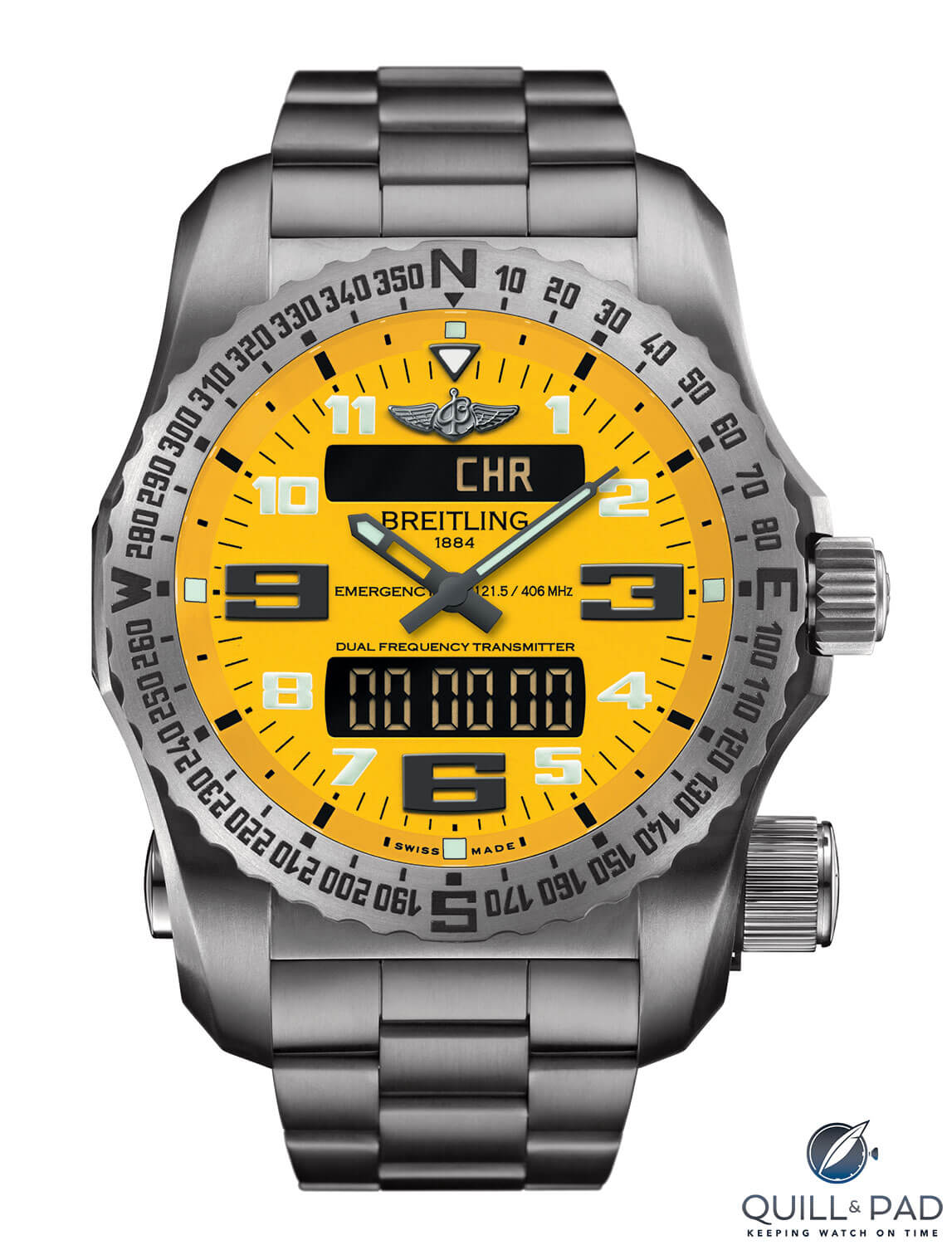
Breitling Emergency II from 2013
Over the years Breitling created several models that have became industry evergreens, among them the Aerospace and the Emergency, the latter even coming with its very own emergency beacon the wearer can pull out of the case in emergency situations.
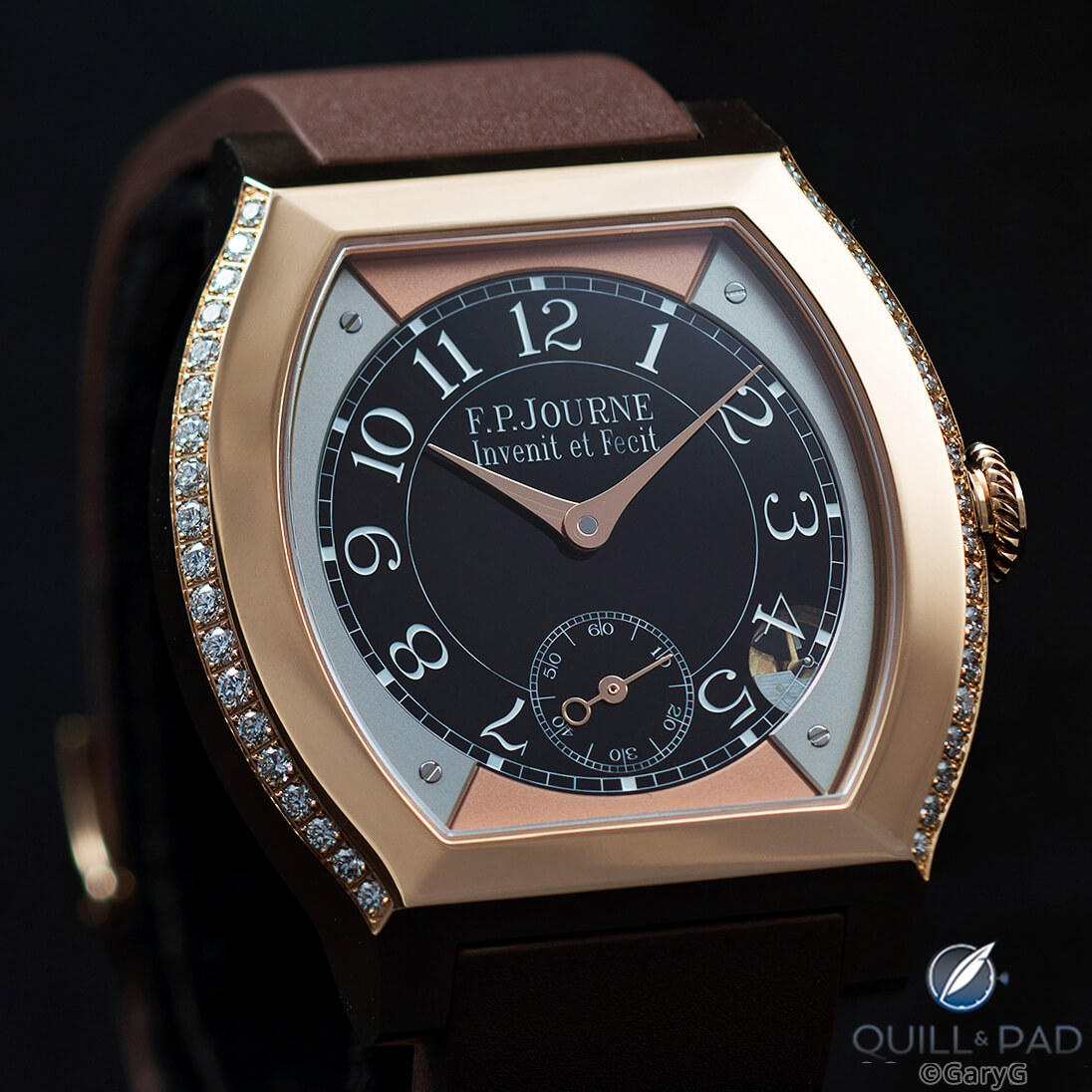
F.P. Journe Elégante
Even François-Paul Journe, often and rightfully lauded as one of the best watchmakers alive, has created his own quartz movement; the quartz oscillator is nestled within his signature solid pink gold bridges (see Quartz Crush: F.P. Journe Élégante 48mm).
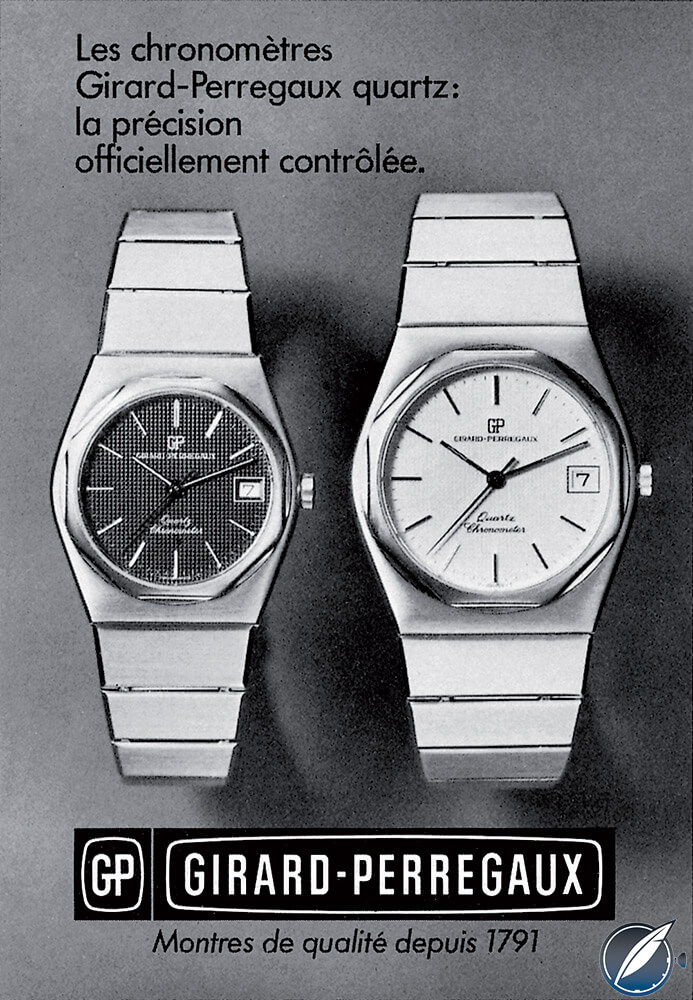
Advertisement for the original Girard-Perregaux Laureato Quartz
Another notable Swiss haute horlogerie quartz watch is Girard-Perregaux’s 2010 re-edition of the original quartz Laureato model issued in honor of the brand’s fortieth anniversary of GP quartz and 35 years of the Laureato line at the same time. It contained a very finely finished Girard-Perregaux-manufacture quartz movement.
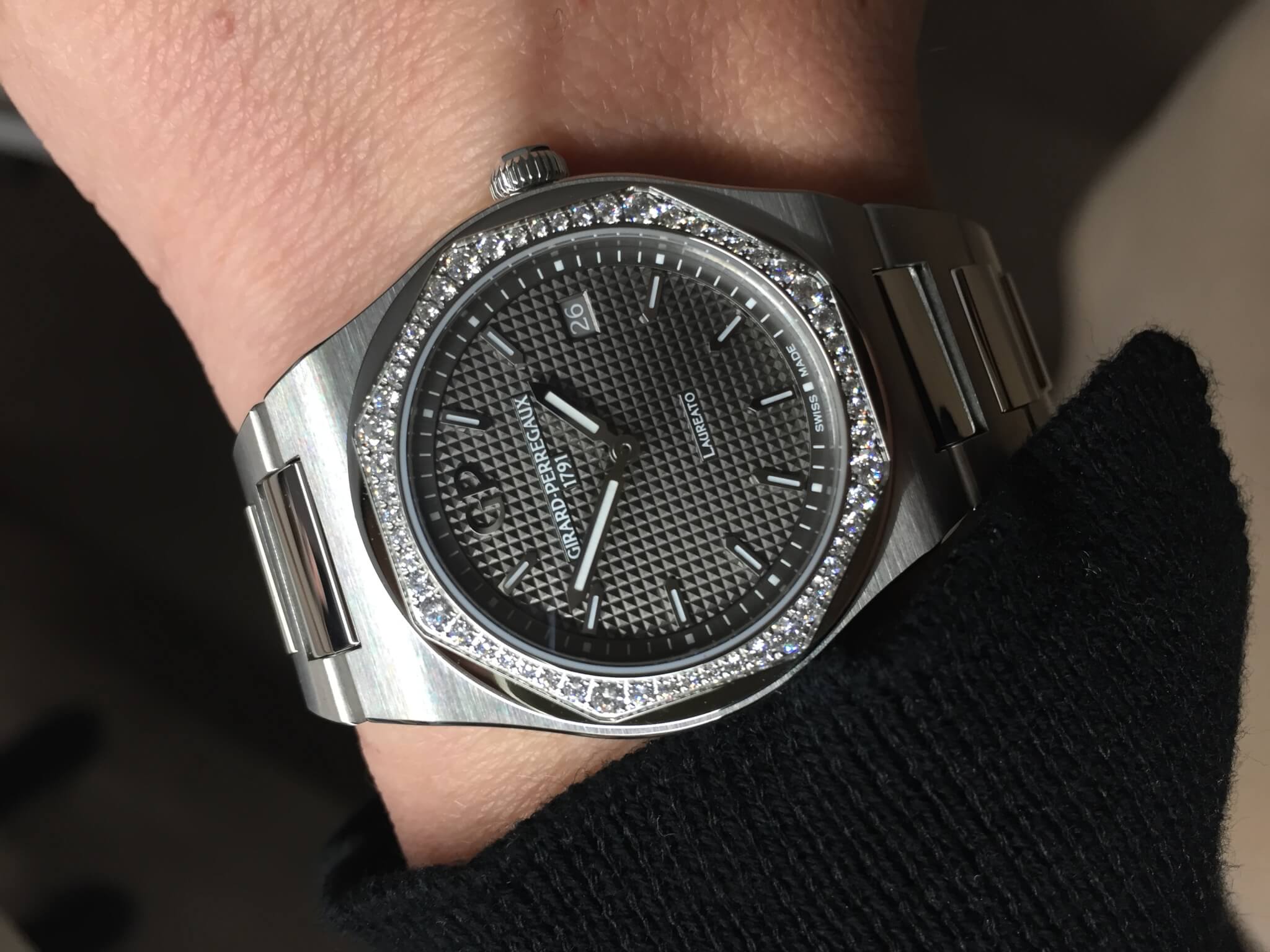
A 2017 Girard-Perregaux Laureato 34 for women with a diamond-set bezel and a mechanical movement; the quartz is gone from the Laureato for the time being
The first Laureato was powered by Caliber 705, a modified version of the Girard-Perregaux 350 quartz movement developed in 1971. Caliber 705 represented a bridge between the quasi-experimental Beta 21 and the ensuing Swiss quartz. By 1975, Girard-Perregaux’s team had refined the brand’s in-house quartz movement so that it was thinner and more efficient. It was also certified as a chronometer. But perhaps most importantly, its frequency of 32,768 Hz has remained the universal gold standard ever since.
The future of quartz – or lack thereof
In a twist of irony seeing as quartz once almost sealed the fate of the mechanical movement, it now might be the smartwatch that kills the quartz watch as its first victim.
While the mechanical watch might not be as accurate as electronic quartz or the smartwatch, it claims an emotional bond based on traditional skills and crafts as well as the complexity of its movement.
Largely thanks to the advent of quartz movements, mechanical watches have become a form of luxury and even are even considered art. Apart from Journe’s Élégante creation, it is highly unlikely that the common quartz watch would experience the same destiny.
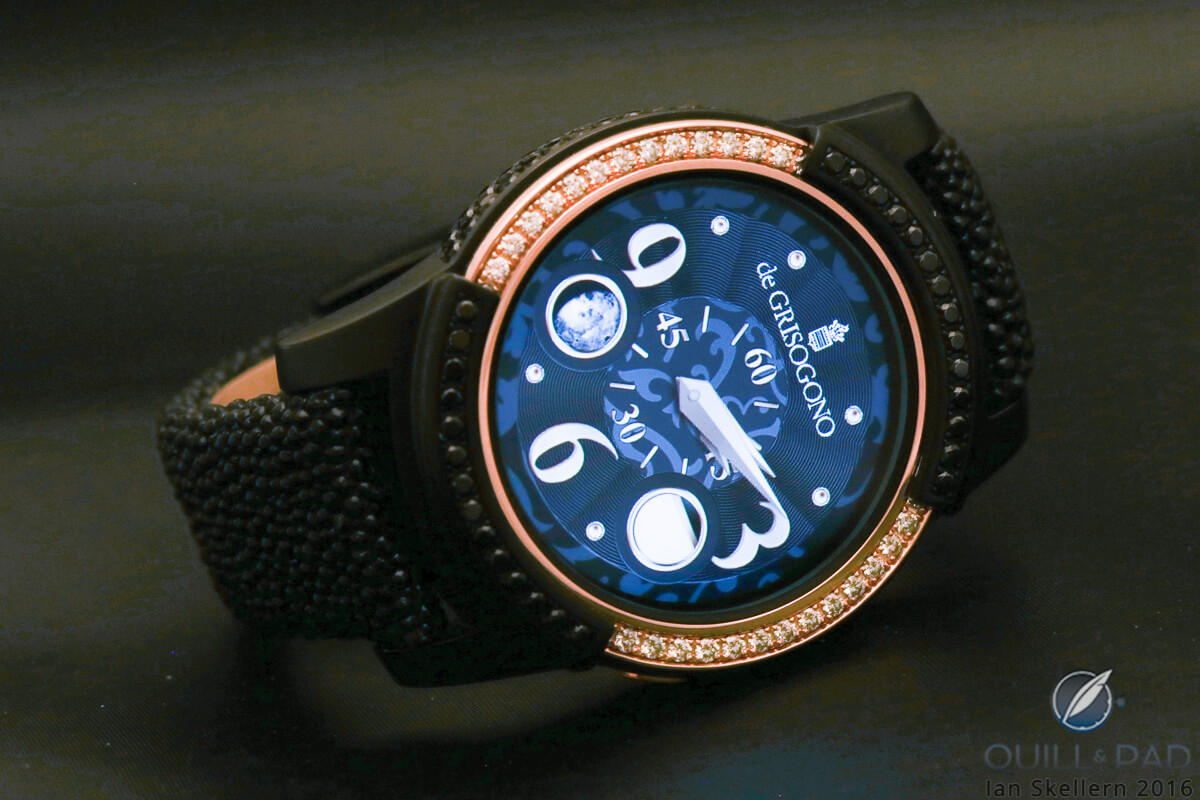
Samsung Gear S2 by De Grisogono
As more and more brands adopt the concept of the smartwatch, the quartz watch loses it edge – as happened with the electric watch and the Accutron before it. It might stand on equal footing in terms of precision, but it cannot compete with the vast array of additional functions that any smartwatch can offer.
The common quartz watch is likely to be outgunned and, especially as prices of smartwatches come down: for quartz watches, I predict a classic case of the hunter becoming the hunted.
* This article was first published on October 4, 2017 at Quartz: Past, Present, But No Future?
You may also enjoy:
Design Discussion On Contrast & Texture: How Vantablack And Other Techs Are Disrupting Watch Norms
Leave a Reply
Want to join the discussion?Feel free to contribute!



Hmmm, I’m not sure about the relevance of mentioning the Bulova Accutron here… The tuning fork technology they were using although electronic, outdates the first quartz prototypes and has absolutely nothing to do with the quartz technology. So saying it did help show the path that there was big potential in embracing quartz is at best a stretch, at worse, absolutely unworthy a serious horology blog as yours.
1. I absolutely disagree. The history and evolution of electronic i.e. electric wristwatches needs to be dissected to understand how each new innovation replaced what was previously the peak of technology.
2. Unrelated, I think that quartz movement (and digital) watches will remain part of the market–albeit a much smaller fraction than today–because they will always be tougher than any smartwatch. I am interested in seeing how well the smartwatches will go with incorporating solar power into the watch case. (Besides my love of mechanical movements) I currently would not want a smart watch precisely because they are just a wrist version of a cell phone, with less functionality. I can pull one of my mechanical or analog or digital quartz watches out of the drawer, and just run out the door, not worried about when I will return to civilization. As an “outdoorsy” person I want stand-alone timekeeping that doesn’t depend on cell reception, car chargers, etc.
This article makes a very glaring omission – the Japanese. Unlike the Swiss, who abandoned quartz in the 90s, the Japanese never gave up on it. Grand Seiko still produces the 9F movement, which is as well made and finished as automatic and mechanical movements from other luxury brands, while Citizen continues to push the limits of accuracy with the 0100. Seiko, Citizen, and Casio have also continued to increase the functionality of quartz watches by adding perpetual calendars, jumping hour hands, atomic clock and GPS time syncing, and other features. The Swiss still offer a few high accuracy movements and Junghans in Germany sells the solar/radio MEGA model line, but they’re the exception.
Smart watches may very well kill the basic quartz watches that fill the cases of shopping malls and jewelry stores, but the Japanese are giving smart watches a run for their money by giving people who want maximum functionality in an analog form something worth buying.
Well put. Couldn’t agree more.
I’ve worked in software over twenty years and I still have no desire to wear a smart watch. The screens and batteries are simply too limited. I have a nice solar Casio ani-digi hybrid coming in the mail. It never needs a charge and will re-sync to radio atomic clocks every night. That’s what I want from a watch.
It is incorrect that Omega’s Marine Chronometer was certified at Neuchatel. It was certifoed at Besancon.
“Swatch gets the credit for successfully reclaiming quartz for the Swiss by beating the Japanese at their own game”
Swatch watches were crucial at one point but it is now undoubtedly The Japanese who own both the quartz sector and the lion’s share of sales in number of units. Casio (the most catastrophically under-rated watch manufacturer in history) sells 3 million F91-W watches per year and a few years ago celebrated its 100 millionth G-Shock. You don’t see many people going into combat with an Apple watch, but G-Shock became the unofficial watch for all military and emergency personnel a long time ago.
Of course ABC watches have to be quartz also. These are not rich man’s trinkets; they can literally be vital.
I think many “purists” would benefit from having a good long look at what these movements can do. Casino’s high end movements are extra-ordinary, not to mention Citizen’s.
I would welcome such an article in this magazine.
Quartz has no future!? The Longines L288 is a new super Quartz movement.. You have the Grand Seiko Spring Drive movement, the Citizen 0100, the Oceanus 5596… The list goes on. You need to do your homework before you publish rubbish like this.
I had a smart watches. No more. They are 2-5 year lifetime products, made obsolete buy battery degradation and increasing processing demands from SW updates. Yes, multi-functional, but they will never be passed down from one generation to the next. Just more disposable hardware to end up in the e-waste stream.
There will always be mechanical, quatz and smartwatch watches. People adopt these for various reasons some of which is the functions they perform, the materials they are made of (these are ornaments) and how much they cost. People own more than one smartwatch, for example, a person may own a dedicated gps golf shot tracker and a second watch for tracking number of steps on long walks. As functions in these watches come together there will be a consolidation. There are also hybrid watches that cuts across these watch classes. I don’t see how a class of watch can wipe out others because the watch classification you have used is also limited.
I have a H. I. S quartz wristwatch that says made in Japan on it.
I can’t find any information on this wristwatch anywhere. Does anyone know anything about this watch